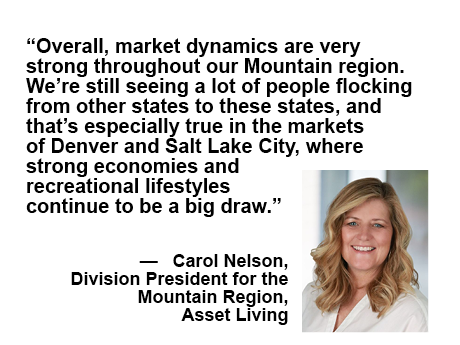Population growth in the Mountain states over the last several years has fueled historic apartment construction across Colorado and Utah. The activity has created some supply overhang in the Denver and Salt Lake City markets in particular, but continuing in-migration, housing shortages and the high cost of home ownership could sustain their resiliency, say two of Asset Living’s newest executives in the region.
Based in Houston, Asset Living manages assets valued at $55 billion nationwide, including more than 1,750 apartment properties in addition to student, affordable and single-family build-to-rent housing. More than 400 Asset Living employees manage 21,000 multifamily units in its Mountain states, which, in addition to Colorado and Utah, spans Montana, Idaho, Wyoming and the Dakotas.
The property manager’s apartment portfolio in the region has consistently maintained an average occupancy of 95 percent, which exceeds industry and market benchmarks, the company says.
“Overall, market dynamics are very strong throughout our Mountain region,” says Carol Nelson, who became Asset Living’s multifamily division president for the region in June of 2023. “We’re still seeing a lot of people flocking from other states to these states, and that’s especially true in the markets of Denver and Salt Lake City, where strong economies and recreational lifestyles continue to be a big draw.”
Steady Growth
Indeed, since 2020 alone, Denver’s population has increased nearly 5 percent to 2.96 million, while Salt Lake City’s has climbed roughly 4 percent to more than 1.2 million, according to Macrotrends, a research platform that serves long-term investors.
As is often the case with high-growth areas, however, new construction escalated prior to the spike in interest rates and a wave of deliveries are affecting fundamentals. In Denver, completions totaled nearly 11,000 units in the 12 months ended March 31, but over the next 12 months, they will likely double, notes RealPage Market Analytics.
Meanwhile, Salt Lake City saw record deliveries of 7,600 units in the 12 months ended September 30 in 2023, and RealPage projects an additional 12,000 units will be completed by the third quarter of this year.

Asset Living
Given high interest rates and construction cost inflation — along with the deep pipelines — multifamily developers have reined in starts in the two markets, remark Nelson and Kellea Jeffrey, who in November joined Asset Living’s Mountain region as senior vice president of multifamily operations.
Still, as a result of the new supply, occupancy and rental rates have flattened in both markets and in some submarkets have even softened, Nelson and Jeffrey say. But in Denver, which faces a tight housing market in general, demand at the moment remains stable enough across much of the metro.
“It’s going to take some time, but we think the broader metro will begin to firm up and drive more rent growth in 2025 as deliveries begin to subside,” Jeffrey reports. In the city’s urban areas, new development has largely targeted the popular Lower Downtown (LoDo) and River North Arts District (RiNo), she adds.
“In RiNo specifically, we’ve seen commercial and residential development really take off in what used to be a railyard and warehouse district,” Jeffrey states. “It’s now a very walkable neighborhood with fresh businesses, shopping and breweries.”
Lifestyle Distinctions
Historically, Salt Lake City’s apartment growth has run about five to seven years behind Denver, Nelson says. But today, supply mimics Denver more than ever relative to population, she points out.
That may be where the similarity ends. While the recreational and economic opportunities of both markets are attracting new residents, to date their policies and culture have diverged.
“We’re seeing a lot of western state migration into the Mountain region — certainly there are a lot of Californians coming into both Colorado and Utah,” explains Nelson.
Multifamily Policy Trends
Some of Colorado’s policies present challenges for apartment landlords and property managers. This trend emerged notably during the pandemic and persists as state lawmakers address the ongoing housing affordability crisis. Among other measures, Colorado has put restrictions on application fees, capped rent and prolonged eviction periods.
“There have been a lot of small changes,” Jeffrey notes. “Some have hampered the ability of landlords to generate income. We remain hyper-focused and consistent on allowing recoverable expenses and, while not an income stream per se, we are leveraging technology and AI platforms to improve income collection and reduce labor costs.”
— By Joe Gose. This article was written in conjunction with Asset Living, a content partner of Multifamily & Affordable Housing Business.
To learn more about Asset Living, click here.
For more information on becoming a Multifamily & Affordable Housing Business content partner, contact Rich Kelley.


